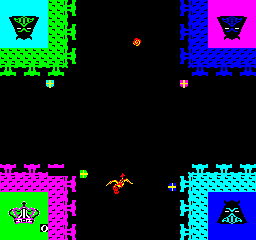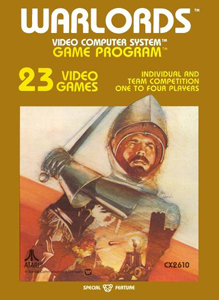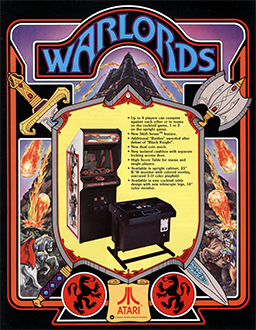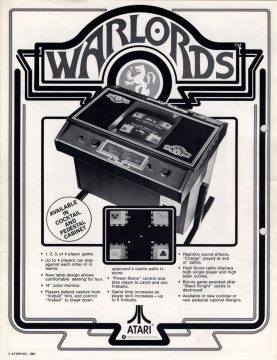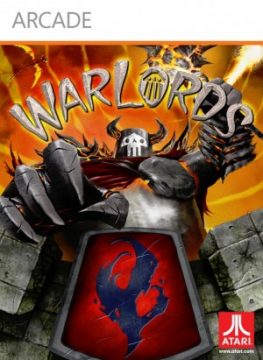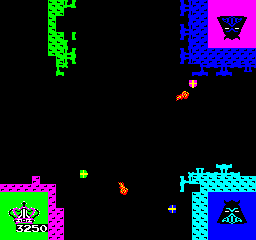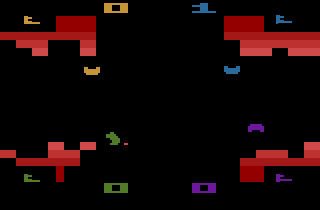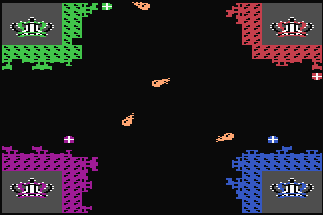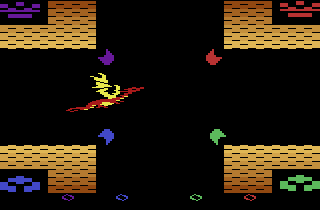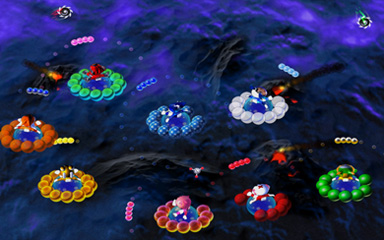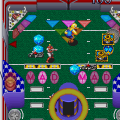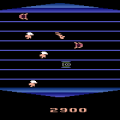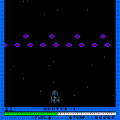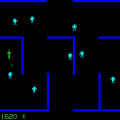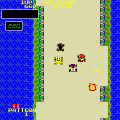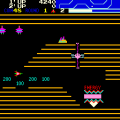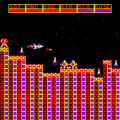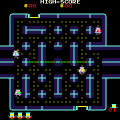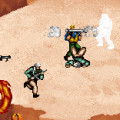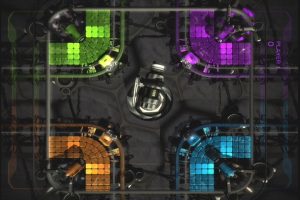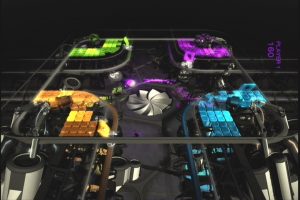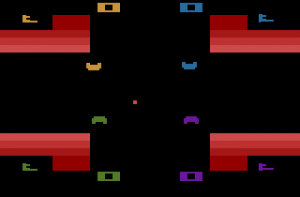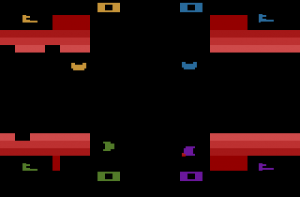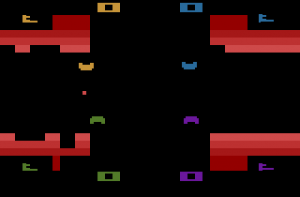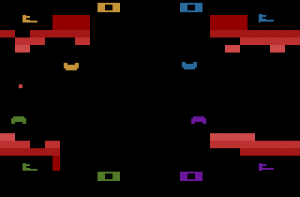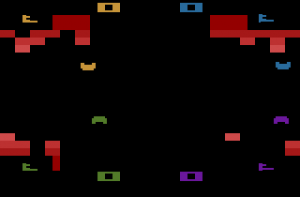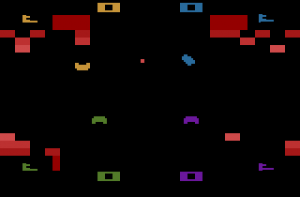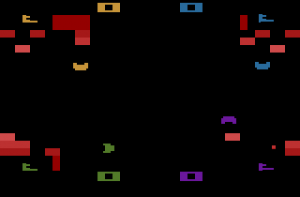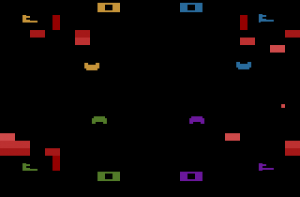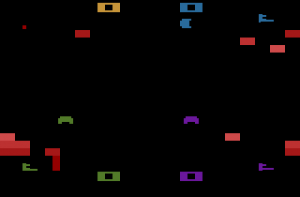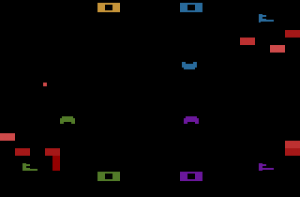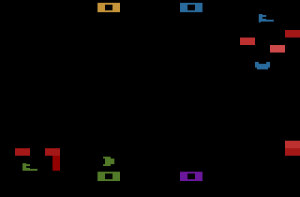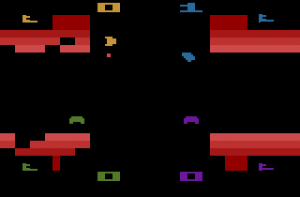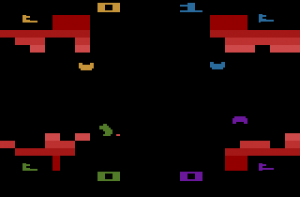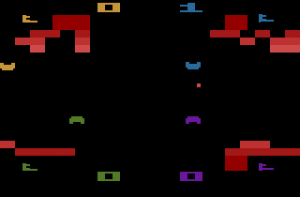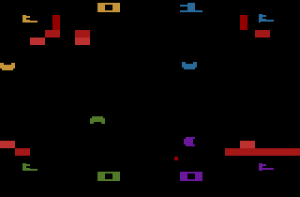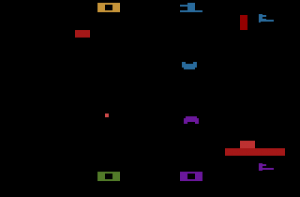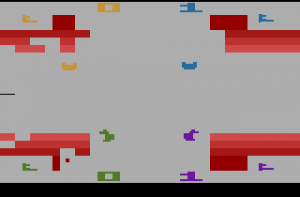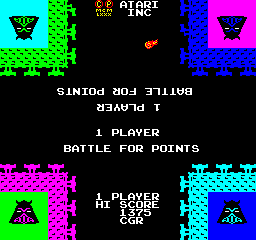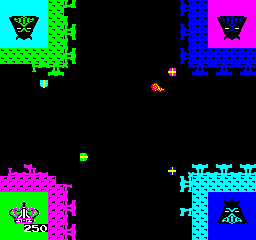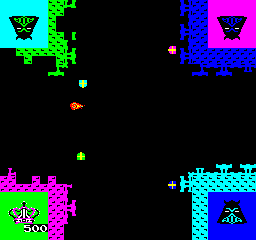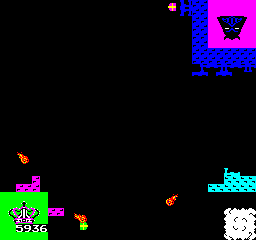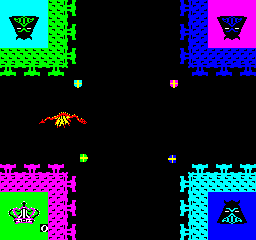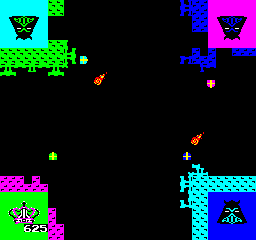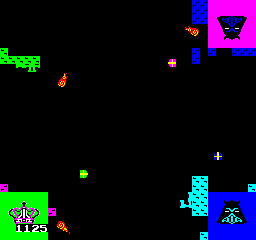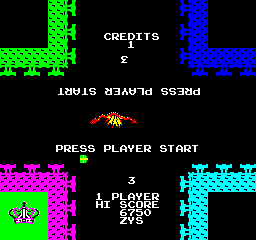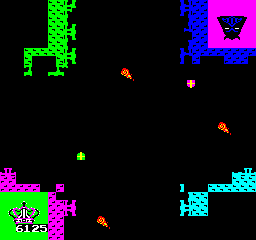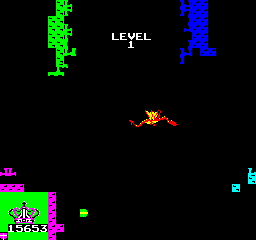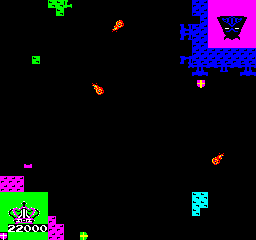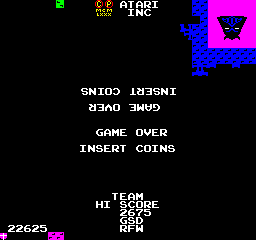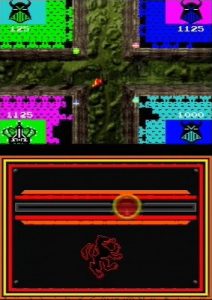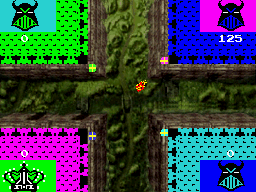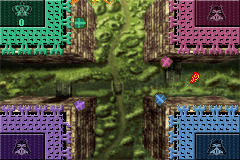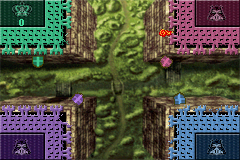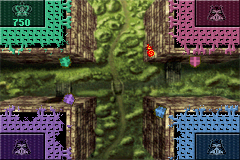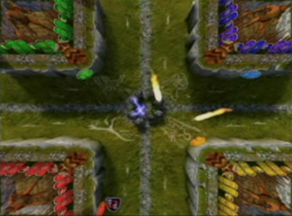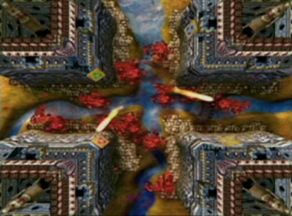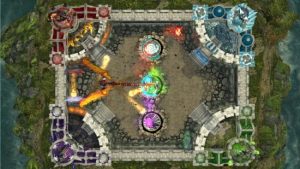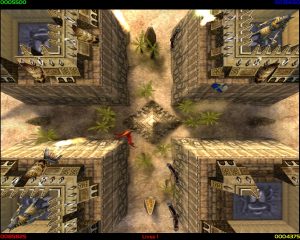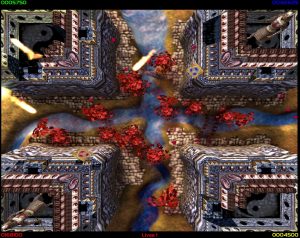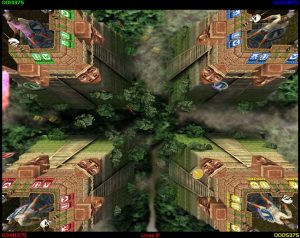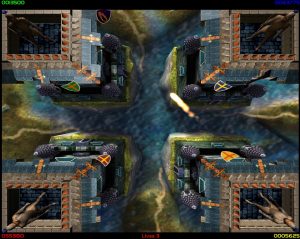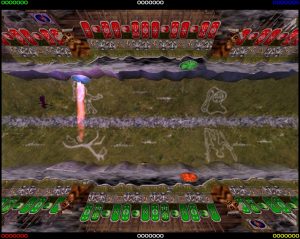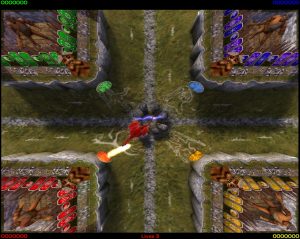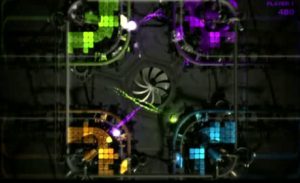If you were to dig around in the 2 player menus of Boom Blox, Stephen Spielberg’s contribution to the world of gaming, you’d find a particular 4-player turn based game called Bombardment. Each player has their own castle, and the objective is to throw bowling balls (likely representing cannonballs) at the other 3 castles, slowly destroying their defenses and clearing their gem blocks from the board. A word of caution, however, as clearing certain blocks from enemy forts will grant them extra firepower on their turn, and certainly, they’re going to remember who it was that tried to do them in. You need to be aggressive, but also tactful, cunning, and ready for whatever blowback you bring upon yourself. If all of this sounds vaguely familiar, it’s because Bombardment pays blatant homage to one of the greatest party games of the pre-crash era. The third map in particular, which places each of the castles against the 4 corners of the board, bears more than a striking resemblance. The name of said map: Warlords!
While Boom Blox‘s tribute does change the pace quite dramatically, making it perhaps slightly more strategic, it wonderfully preserves the diplomatic nature of the game. Originally billed as a 4-player free-for-all, it didn’t take long for players to realize the benefits of striking up a few under-the-table negotiations. In most games of this nature, a particularly skilled player would be able to dominate the board one round after the next, but if the three weaker players forge a temporary alliance, and collectively deal with the one stronger player, they stand a better chance of taking him out, restoring a certain amount of balance to what would have been a one sided fight. Of course, such alliances are fragile, and each player much constantly be on their toes, otherwise one of their fair weather allies might try to stab them in the back at the opportune moment. The major turning point between Bombardment and Warlordsis that Bombardment is turn based, giving you, and your opponents, time to think. In Warlords, everything is happening all at once.
Created by Atari in 1980, back when the company could do no wrong, Warlords‘ plans for global domination started in the arcades. The gameplay was straightforward enough, especially if you’ve ever played Breakout. The game always has 4 players, whether they be human or computer controlled, and each player starts off with their own castle in one of the 4 corners of the board, and has to defend said castle with nothing more than a shield, which you control using a Pong / Breakout style spinning paddle. To kick things off, a dragon will fly around the middle of the board, and launch a fireball into play, and each player then uses their shields to deflect the fireball, and try make it hit the other castles. Doing so causes a certain amount of damage, depending on where it hits, and how fast it was going at the time. Break down enough of a castle’s defences, and the warlord within will be exposed. Hit the Warlord and that player is taken out of the taken out of the game, and a second fireball will be launched from whatever remains of his or her castle. This pattern repeats until there is only one player left standing. Additional fireballs will also appear on their own if the game goes on for too long.
Best of all, by holding down the “power stone” button just as you’re about to hit the fireball, you’ll catch and hold it in your shield, allowing you to aim where it will go when you let go of the button. You can, and will likely need to, deflect other fireballs while holding. It’s this ability to hold and aim the fireballs that make this more than just a four player Breakout variation. Now, you can grab what amounts to a weapon, target a particular opponent, and fire, but not without risk. There’s always the possibility that the fireball will get deflected and come back your way, or you could end up provoking a fight with the player whose castle you just tried to hit, leading to an onslaught of attacks from that person. Players don’t really get a great deal of time to think over moves, as there’s often more than one fireball to deal with, but knowing whose on your side (for the moment) and who needs be dealt with are essential skills, and ones which you must constantly employ in a series of snap decisions.
The arcade unit itself came in both a 2 player upright, and a 4 player tabletop, or cocktail unit, if you will. Playing the game in either 1 or 2 player modes will pit the player either alone against 3 AI controlled warlords, or with an ally against 2 of them. Win, and you advance to another level of much the same thing, but with slightly faster moving fireballs. Playing on either 3 or 4 player modes will immediately toss level progression out the window, resulting in the early arcade equivalent of a Battle Royal. This would also mean that the game ends after a single round, regardless of who wins, but the machine could allow a 4 player game off a single credit.
All was not well, however, with the arcade version of Warlords. To start, only about half of the arcade units produced were cocktail, meaning many players never even got to try the game’s 4 player mode. This was a real problem as the AI tend to jump randomly between borderline invincible and completely moronic, and a clever player will easily exploit their inability to multitask. In 1 player mode, things can get pretty one sided, as all three other warlords are clearly aiming to take you out. They might, every now and then, take opportunistic pot shots at one another, but most of the time, they work as a team to bring you down. Even the dragon that hurls the fireball at the start of every round tends to do so in the direction of player 1’s castle more than the others, even in multiplayer games. Visually, the game just doesn’t appeal. The upright is in black and white, with an aesthetically displeasing overlay, while the colour choices on the cocktail version contain some highly questionable shades of neon, not to mention the AI controlled warlords bearing an odd resemblance to Darth Vader.
The game also has a tendency to be fairly short, with individual rounds lasting around a minute. All 4 players can play off one quarter, but this beast can still devour those quarters at an alarming rate. By the time you’re down to the last 2 players, there will be at least 3 fireballs bouncing around, and the whole thing easily descends into chaos, leading to many situations where luck plays a bigger role than skill. The shields themselves are fairly small, and learning to manoeuvre them around that corner is going to take some getting used to. Worse still, the physics can feel a bit off at times, meaning the fireball, even when aimed, is never fully under any player’s control. Given that Pong obeyed reasonably believable physics, it’s odd that a later, more advanced game would have problems in this department.
Overall, Warlords is fantastic because, despite it’s obvious flaws, the core gameplay is fully intact, in all it’s diplomatic glory. If you’re looking to add this to your MAME collection, however, I’d advise you to be ready for some setbacks. The ROM is certainly out there, and it runs fine, but without the paddle controller, you’re hobbling the experience right off the top. Breakoutmight have been playable with the mouse, once you got over it’s little quirks and hiccups, but doing the same thing around a corner is far too awkward. Using the arrow keys is a bit easier, but still puts you at a disadvantage.
Given that it’s been thoroughly reappraised by today’s class of retro-gaming enthusiasts, it can be hard to gauge how successful Warlords was in the arcades, but we do know one thing for sure. As popular as it may or may not have been, only a year after it’s debut, the arcade version was completely upstaged by it’s home console counterpart. Often referred to as the best game on the Atari 2600, which is saying a lot, this is the version that most often comes to mind whenever you hear people talk about Warlords, and perhaps rightly so.
Like so many of the arcade games ported to the console, a lot of things had to be severely scaled back. Instead of taking away from the quality of the game (I’m looking at you Pac-Man) it had the odd effect of improving almost every aspect. Right off the top, the game has a much more subdued colour scheme, which looks significantly better than the bright neon motif of the arcade, and much of the game’s unappealing visual style has been reduced to a merely functional block representation. It’s hardly pretty, but it’s not ugly either. The sound has been reduced to your typical assortment of Atari noises, which also end up sounding a bit cooler. As for the gameplay, it too was scaled back, and this too would turn out for the better.
The board itself is shaped a bit differently, so as to more comfortably fit your television screen. Instead of everything being perfectly square, like in the arcades, each of the castles are now wider than they are tall. This means that you’re far more vulnerable to horizontal attacks than vertical ones. In other words, when the chips are down, you can place your enemies into a hierarchy based on their threat level. The player to your left/right being the most dangerous, followed by the one above/below you, then the one who is across the board diagonally from you. Gameplay-wise, this doesn’t make a great deal of difference, but if you have to choose between the two, it can help to know you need to make friends with in order to survive. Remember, you are equally threatening to the other players, and in the same order. Plus, this time around, there’s only one fireball in play, keeping the game from descending into chaos, and making it that much easier for players to implement their strategies, not to mention that any time a player holds the ball, it provides a short break, giving everyone a chance to negotiate with one another… or to try and sweet talk the player holding the ball.
The most obvious gameplay improvement is that you no longer have to pay to play. Now, this would normally go without saying, but what it means here is that games are no longer a single round each. Instead, at the end of each round, the last warlord standing earns a point, then the board is reset and the next round commences. In order to be declared the winner, a player must earn five points. This means that a single game could have as many as 17 individual rounds before someone finally wins. This might seem like a superficial change, but it actually introduces a new level of strategy to the game. Instead of every decision being made in the moment, for the moment, players must now devise long term strategies as well. If any one player starts to get close to that 5 point mark, for instance, all 3 other players share an equal risk of losing the game, and must work together to shut that player out… that is, until someone else starts to dominate, and then everyone shifts their plans.
Alliances, thus, remain in flux. You can’t afford to have all three other players against you, so you need to play by their terms, but at the same time, everyone is out for the win, and no one can be trusted not to stab you in the back. It’s all the intrigue and diplomacy of the arcade version, amplified several times over. If this doesn’t sound like the juiciest guilty pleasure of all time…
As with most Atari games from this time, Warlords has several different modes, which vary the speed of the ball, whether or not to disable catch mode, as well as the number of players. There’s also a “doubles mode” which allows two players to control two shields each. It’s an interesting way to get around the AI problem when you only have two players, but isn’t particularly exciting otherwise.
There are still a few minor complaints to be addressed. For one, the game physics are even more bizarre than the arcades, with the fireball sometimes hooking to one side in mid-throw. Also, the AI this time around is incredibly stupid. The AI does have the common sense to mirror your movements from time to time when you’re holding the ball, but aside from that, they’ll engage in all manner of annoying idiocy, like deflecting the ball against the back end of their shield over and over again, causing damage to their own castle, and even taking themselves out completely. Playing against the AI is never going to be as fun, or as balanced, as playing against human opponents, but this is just sad. Much like the arcade game, it’s far from impossible to find a working ROM, but playing with the mouse really takes away from the experience. Luckily, if your 2600 still works, this game can generally be found quite cheaply and easily. It’s also available on the Atari Flashback (the first one) though this one uses joysticks instead of paddles.
Or you could consider buying one of the many remakes. Without the paddle, control will likely be an issue, but since these games are ports rather than emulations, it’s usually a bit less severe. Most versions come bundled with other classic Atari games, and offer a near-perfect reproduction of the game, usually in it’s arcade form. Some try to dress up the graphics a bit by also recreating the overlay, which isn’t nearly as distracting as it looks in screenshots, but also doesn’t look nearly as good as stark blackness. The Game Boy Advance version (which appears on a 3-in-1 cart with Breakout and Centipede) features this overlay, as well as some slightly redrawn graphics. This port is a bit sluggish, with strange controls and particularly nasty AI, but it somewhat captures the spirit of the game. There are also straight emulations featured on the Atari Anniversary Edition pack, for the PlayStation, Dreamcast and PC, Atari Anthology for Xbox and PlayStation 2, Atari Masterpieces Vol. II for the N-Gage, and in Atari Greatest Hits for Android and iOS.
Of course, in recent times, as it becomes fashionable, once again, to heap praises on the older games, a few feeble attempts have been made at updating the game. At best, these games do nothing more than make it look severely goofy, but sometimes they also hurt the quality. Three particular attempts stand out.
In 2002, as part of Atari’s 30 anniversary, the company took three of its early hits – Combat, Missile Command and Warlords – and tried to make them look like current generation titles. These three were released together in a pack called “Atari Revival”. None of the games survived unscathed. Warlords technically uses 3D graphics but keeps the perspective in 2D. There are now ten different themes, sorta based on various periods of world history – prehistoric, Egyptian, Japanese, Incan, European Medival, and Arctic. From there, the themes get crazier, like an Atlantean theme, or castles floating in the clouds above World War I themed England, along with outer space and alien themes. Graphically, the updated version of Warlords could look worse, and it’s a nice touch that there’s more than one graphic design, but from a gameplay perspective, the new look is seriously problematic. While those redesigned, 3D fortresses look pretty good, it’s nearly impossible to tell the damaged areas from the solid ones. This leads to more than a few mid-game “surprises” that would have been avoided with a simpler design. The shields are a bit bigger, and there are usually plenty of balls in play at once, which are shaped like fireballs.
There’s also gameplay-altering powerups, such as invincibility, or the ability to reverse someone else’s controls, or make fireballs disappear, speed up or slow down. There are also bonus stages in single player mode where you have to toss fireballs back at the dragon, as well as a co-op mode which realigns the castles to something more similar to Breakout. There’s also the ability to play multiplayer over the internet, although good luck finding anyone to play against. The music is subdued and completely forgettable, though some of the sound effects are actually pretty badass. Thankfully, the game also has a perfect reproduction or the arcade game, and even goes the extra mile by subduing the gaudy color scheme, and interlacing the arcade graphics. As a complete package, however, it isn’t really worth it.
Warlords is also one of the games on the Retro Atari Classics collection, which came out in 2005 exclusively for the Nintendo DS. This is a compilation of classic Atari games, with various touch screen implementations. In theory, this really should work, as the touch screen can easily best the mouse when it comes to emulating analog control, but here, it just feels clumsy, despite being at least decent on some of the other games. Graphically, the game can be played in both classic and “tagged,” which basically means that a new visual aesthetic has been designed by one of three “world famous” graffiti artists. Once again, classic perfectly reproduces the questionable colour scheme, and overlay from the arcades, with some strange cartoony creatures added to the tagged version. It’s as cheesy as it sounds, but not necessarily ugly. Thankfully, there’s no music, and the sound has been reasonably preserved, for what it’s worth. The game also only has one ball in play, which is for the better, as far as I’m concerned. Multiplayer, which should have been the focal point of the entire compilation, is also lacking in a very big way, with multi-card being the only available option.
Warlords also received rather glossy new versions for the PSP as part of the Atari Classics Evolved pack in 2007, as well as a separate release on the Xbox Live Arcade in 2008. Both a perfect port of the arcade version, as well as a new “evolved” mode, which features a ridiculous looking science fiction theme, with even brighter neon colours. It features a lot of unnecessary graphical touches – since it’s fully 3D, you can tilt the playing field at a number of angles – but it looks extremely cluttered. While the graphics and visual effects are good, they’re a bit hard on the eyes, and while the music does sound very good as well, it’s also quite generic. The Xbox Live version has some nearly useless support for the camera, as well as online multiplayer. It’s not so much that playing Warlords with people from other countries is all that exciting, but it means that there will be very few times when you’ll actually have to endure playing against three AI controlled opponents. However, it only runs at 30 frames per second, which is a crime for a game so simplistic looking, on such powerful hardware. As a result, it doesn’t feel as fast nor as smooth as it should. Like the Windows version, the shield has been made bigger, has multi-ball play, and even adds collision mechanics for when the balls bang into one another. To that effect, the physics definitely appear to have been improved. Fans seem to be divided, with some seeing it as an improvement, and others seeing it as an abomination.
In 2011, Atari released a remake of Warlords for Xbox Live Arcade again, as well as on the PSN.
Tributes
Like many classic games, Warlords has it’s share of imitators, but far more interresting are some of the games that have openly paid homage. Boom Blox was one of them, here are a couple others.
Castle Crisis / Medieval Mayhem – Atari 2600 / Atari 5200 (2004/2006)
Castle Crisis and Medieval Mayhem are a couple of homebrews, created by classic gaming enthusiasts, in order to more accurately replicate the gameplay style of the arcade version on home consoles. Castle Crisis was created by Brian Edewaard in 2004 for the Atari 5200, as well as Atari 8-bit computers. Medieval Mayhem was created in 2006 for the Atari 2600 by Darrell Spice Jr. Both ports offer several different play options, as well as a reasonably faithful reproduction, within the limits of their respective consoles. While the scaled back version has it’s own merits, it is certainly impressive that someone was able to do so much more with the same technology. If your Atari consoles still work, you might want to look into trying these games out.
Airburst / Airburst Extreme – Macintosh / Mac OS X / Xbox360 (2001/2004/Unreleased)
Airburst was a Mac exclusive game, released in 2001. While official documentation refers to the game as an “inverted version of Pong,” the resemblance to Warlords is unmistakable, though with a flavour unto itself. This time around, your Warlord is some funny looking guy sitting on a balloon, surrounded by several layers of protective balloons, which act as your fortress. By deflecting what looks like a balloon with spikes, you must try to get past the other players’ protective balloons and pop the big one from underneath them, sending them hurtling towards the ground.
The major difference, gameplay-wise, is that you’re no longer confined to the corner of the screen, which means you’re vulnerable to attack from all directions. There are also several powerups, and roughly 15 different modes of play. Some stages, for instance, will have more than four characters, while others will start off with your shields severely crippled, or give objectives other than merely surviving the longest. The only complaint is that things can get chaotic very fast. Within seconds of the round starting, you can find yourself dealing with 8 balls at once, from all sides, and deflecting them will cause your character to start moving around, just from the inertia. The catch feature that gave Warlords much of it’s strategy is now delegated to one of the powerups, so this is a game of chance at the best of times; at the worst, you just spin frantically and hope for the best.
In 2004, a Mac OSX port was released, called Airburst Extreme, which added a largely unnecessary story, and even more insanity. Now, there are 32 different modes of play, and each successful deflection will allow you to build thrust, which you can use to control your movement, or build it up in order to unleash some kind of special power, ranging from self repair to temporary invincibility, or the obligatory “mess up everyone else’s controls” move. The backgrounds are now animated, in order to enhance the sense of height, and everything looks a bit nicer. The music is a bit on the generic side, though the song “Pop Pop Pop” which plays incessantly during the demo version, is just sinfully catchy, despite being completely silly. Airburst Extreme also introduces online multiplayer.
Overall, it’s a lot of fun, and a wild party game, though it’s far too frantic to actually upstage Warlords. Still, decent Mac games can be hard to find, and this one is definitely worth the price of admission. In 2007, it was announced that Airburst Extreme would also be coming to the Xbox live arcade, though no word yet on the release date.
